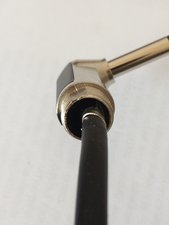Hi @apromaco ,
There may be a problem with the cable.
Try disconnecting the wires from the jack that you soldered and measure the resistance from the inner wire of the cable to the tip of the jack at the other end of the cable.
Then measure the resistance from the shield wire of the cable to the sleeve of the jack at the other end.
Then measure between the two wires of the cable and check that there is no connection between them.
You can also measure the jack from connector terminal to tip for continuity - 0 Ohms, and also the same for the sleeve and between tip and sleeve (no continuity) to make sure that the jack is still OK after your soldering efforts, which aren't too bad, I’ve seen a lot worse ;-)
Tip for future when connecting the shield wire to the sleeve, double it back over the cable sheath and crimp it between the cable sheath and the crimp lugs that way you won't have to solder it to the sleeve and apply a lot of heat which may damage the cable sheath and possibly the centre wire. You can cut off any excess that goes back past the crimp lugs.
Alternatively “tin” the sleeve i.e. coat it with solder, where you want to solder the shield wire to, beforehand and also “tin” the shield wires as well that way when you go to solder the wire to the sleeve it will solder more quickly meaning that you don’t have to heat up the jack so much for the solder to melt in both the shield wire and the sleeve connection
With the centre wire ensure that the insulation that covers the wire goes right up to the terminal connector and if possible put a piece of suitably sized heatshrink tubing over the wire, slide it back so that you can solder the wire to the terminal ("tin" the wire and the terminal first - leave the hole open) before passing the wire through the hole and then quickly solder it i.e. you shouldn't need to hold the soldering iron on for long as both the wire and the terminal are already “soldered” and will solder more quickly.
Doing this should prevent the centre wire insulation from melting back too far due to heat.
Then push the heatshrink tube forward over the terminal to ensure that the wire and terminal is covered thus preventing any possible future problems regarding shorting out. The heatshrink tube can be "shrunk" down to wrap tightly around the connection by applying the soldering iron directly onto the tubing. It won't melt it will shrink it. Obviously only do this for long enough to get the desired result.
Cette réponse est-elle utile ?
A voté
Annuler
Indice
2
Annuler
Faites défiler ce fil pour trouver l'endroit approprié pour y placer ce commentaire. Cliquez ensuite sur « Ajouter commentaire à cette contribution » pour le déplacer.















 11
11  366
366  1,4k
1,4k